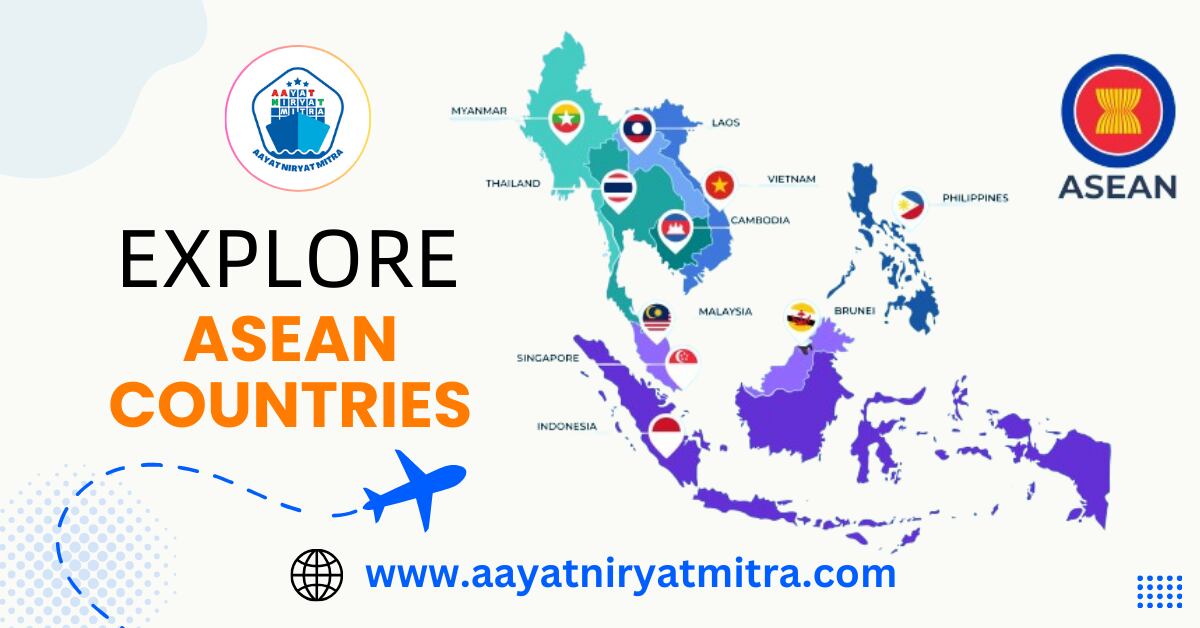The India-ASEAN trade relationship is poised for explosive growth. Discover key strategies to unlock this potential and propel your business forward in 2024.
Introduction:
The Association of Southeast Asian Nations (ASEAN) presents a goldmine of opportunities for Indian exporters. Meet the Association of Southeast Asian Nations (ASEAN), a regional powerhouse established in 1967. This dynamic organization promotes economic cooperation, political stability, and cultural exchange among its ten member states.
ASEAN Full form:
Association of Southeast Asian Nations (ASEAN)
Member of ASEAN Countries:
- Brunei Darussalam
- Cambodia
- Indonesia
- Lao People’s Democratic Republic
- Malaysia
- Myanmar
- Philippines
- Singapore
- Thailand
- Vietnam
A Flourishing Economic Community:
With a combined GDP exceeding $3.2 trillion and a population of over 660 million, ASEAN ranks as the world’s fifth-largest economy. Several key factors fuel this economic strength:
- Free Trade Agreements (FTAs): ASEAN’s FTAs with various countries boost trade and attract foreign investment. Learn more about the benefits of FTAs.
- Complementary Economies: India’s strengths in pharmaceuticals, textiles, and engineering can effectively cater to ASEAN’s growing demand for these products.
- Geographical Proximity: The physical closeness between India and Southeast Asia facilitates efficient logistics and timely delivery of goods.
- Business-Friendly Environment: Many member states offer appealing investment opportunities with streamlined regulations and competitive tax rates.
- Skilled Workforce: A growing young population provides valuable skilled labor for businesses.
Beyond Economics: Building a Stronger Region:
ASEAN’s influence goes beyond economic achievements. The organization plays a vital role in:
- Promoting Peace and Security: ASEAN fosters regional stability through dialogue and cooperation on security issues.
- Sociocultural Development: Programs promote cultural exchange, education, and environmental protection across member states.
- Global Partnerships: ASEAN collaborates with other regional and international organizations to address global challenges.
The Future of ASEAN:
ASEAN continues to drive Southeast Asia’s development. As regional integration deepens, expect to see:
- Enhanced Economic Cooperation: Further trade integration and regulatory harmonization.
- Greater Political Stability: Continued commitment to dialogue and cooperation for regional peace.
- Increased Global Influence: A stronger ASEAN voice in global issues.
Navigating the ASEAN Market:
To successfully export to ASEAN, consider these crucial points:
- Market Research: Thorough research into specific ASEAN countries and their import regulations is essential for tailoring your export strategy.
- Finding Reliable Partners: Building strong relationships with local distributors and importers in ASEAN will ensure smooth market entry and effective distribution channels.
- Cultural Sensitivity: Understanding the diverse cultures and business practices within ASEAN is key to building trust and successful partnerships.
- Compliance with Regulations: Familiarize yourself with each targeted ASEAN country’s import regulations and customs procedures. (Consider linking to a blog post on navigating customs procedures)
Top Indian Exports to ASEAN Members:
Capital Goods and Raw Materials:
- Engineering Goods: A high demand exists for Indian engineering products catering to ASEAN’s infrastructure development.
- Petroleum Products: While some ASEAN nations import petroleum products from India, the demand might fluctuate.
- Organic and Inorganic Chemicals: India is a reliable source of chemicals for various industries in ASEAN.
- Others (potentially includes building materials, wood, etc.): This category indicates a diverse range of goods exported from India to ASEAN, catering to various sectors.
Food and Agriculture:
- Meat, Dairy, and Poultry Products: The extent of import varies, so research is needed for specific countries.
- Drugs and Pharmaceuticals: India’s robust pharmaceutical industry makes it a major supplier of medicines to ASEAN.
- Spices and Rice: India is a well-established source of spices and rice for Southeast Asian countries.
- Oil Seeds: The demand for oilseeds from India might fluctuate depending on domestic production in ASEAN nations.
- Fruits and Vegetables: India has the potential to export more fruits and vegetables to ASEAN with proper logistics and market research.
- Oil Meals (byproducts of oilseed processing): This suggests a potential market for Indian oilseed processing by-products used in animal feed production within ASEAN.
- Other Cereals (likely barley, oats, etc.): This category likely includes items like millets or specific grains besides rice, indicating a niche market for these products.
- Coffee, Cashew, and Tea: These traditional Indian exports continue to find a strong market in ASEAN countries.
Manufactured Goods:
- Gems and Jewellery: India’s renowned gems and jewellery industry finds a strong market in ASEAN.
- Electronic Goods: The extent of electronics imported from India varies. More research is needed to identify specific opportunities.
- Marine Products: India can potentially increase its exports of marine products to ASEAN with a focus on quality and cold chain logistics.
- Plastic and Linoleum: This indicates a potential for Indian plastic and linoleum products in ASEAN markets.
- Cotton Yarn/Fabrics/Made-ups: India’s textile sector enjoys a significant presence in ASEAN.
Industrial Raw Materials:
- Mica, Coal, and Other Ores/Minerals: This category highlights India’s potential to export these resources to ASEAN’s manufacturing industries.
Processed Food Items:
- Cereal Preparations and Miscellaneous Processed Items: This indicates a possibility for Indian processed food exports to ASEAN, but market research is crucial.
Consumer Goods and Textiles:
- Ready-made Garments: This highlights the competitiveness of Indian apparel in the ASEAN region.
- Man-Made Yarn/Fabrics: ASEAN’s demand for man-made textiles suggests potential for Indian manufacturers of synthetic fabrics.
Other Materials:
- Ceramic & Glassware: This indicates a market for Indian tableware, sanitary ware, or other glass products in ASEAN.
- Tobacco: This suggests a continuing demand for Indian tobacco products in some ASEAN nations.
- Leather Goods: The presence of leather imports implies a market for finished leather products or raw materials from India.
- Iron Ore: This is likely for use in steel production within ASEAN, indicating India as a potential source of raw materials.
Home Decor and Crafts:
- Handicrafts: This highlights the enduring appeal of Indian handicrafts in the ASEAN market.
- Carpets: This suggests a market for Indian carpets, which could be hand-woven or machine-made.
- Jute Products: This indicates a potential market for jute-based products like floor coverings or handicrafts from India.
ASEAN Countries Buying From India:
India’s Total Export Value Apr, 23 – Mar, 24 ASEAN $41.21 Bn
| Commodity View | Total Exports Apr’23 – Mar’24 ($Mn) | % Share in selected criteria’s Total Exports |
|---|---|---|
| Engineering Goods | 12,140.29 | 29.46% |
| Petroleum Products | 9,806.15 | 23.79% |
| Organic and Inorganic Chemicals | 3,879.23 | 9.41% |
| Others | 1,993.96 | 4.84% |
| Meat, Dairy And Poultry Products | 1,828.28 | 4.44% |
| Drugs And Pharmaceuticals | 1,661.88 | 4.03% |
| Gems And Jewellery | 1,561.75 | 3.79% |
| Electronic Goods | 1,326.00 | 3.22% |
| Marine Products | 810.4 | 1.97% |
| Oil Seeds | 723.21 | 1.75% |
| Spices | 599.16 | 1.45% |
| Rice | 589.34 | 1.43% |
| Plastic And Linoleum | 523.25 | 1.27% |
| Cotton Yarn/Fabs./Made-ups, Handloom Products Etc. | 511.41 | 1.24% |
| Mica, Coal, And Other Ores, Minerals Including Process | 457.08 | 1.11% |
| Cereal Preparations And Miscellaneous Processed Item | 414.87 | 1.01% |
| Fruits And Vegetables | 400.31 | 0.97% |
| Oil Meals | 382.71 | 0.93% |
| Other Cereals | 231.83 | 0.56% |
| Ceramic Products And Glassware | 218.11 | 0.53% |
| Ready-made garments of all textiles | 210.57 | 0.51% |
| Man-Made Yarn/Fabs./Madeups Etc. | 209.75 | 0.51% |
| Tobacco | 194.01 | 0.47% |
| Leather And Leather Manufacturers | 193.59 | 0.47% |
| Iron Ore | 183.39 | 0.44% |
| Handicrafts Excl. Hand Made Carpet | 47.82 | 0.12% |
| Coffee | 46.41 | 0.11% |
| Cashew | 30.16 | 0.07% |
| Tea | 16.75 | 0.04% |
| Carpet | 12.6 | 0.03% |
| Jute Mfg. Including Floor Covering | 7.43 | 0.02% |
| Total | 41,211.70 | 100.00% |
FAQs on ASEAN Countries Import From India:
-
Q: What are the benefits of trade between India and ASEAN countries?
Ans: Reduced trade barriers through Free Trade Agreements (FTAs)
Increased market access for Indian and ASEAN goods and services
Promotes economic growth and job creation in both regions
Enhances regional integration and cooperation -
Q: What are the top Indian exports to ASEAN countries?
Ans: Pharmaceuticals
Automobiles and auto parts
Textiles and apparel
Agricultural products (rice, spices, tea)
Machinery and engineering goods -
Q: What are the top ASEAN imports from India?
Ans: Processed food items
Fruits and vegetables
Oil meals (animal feed)
Ready-made garments
Man-made textiles and fabrics -
Q: What are some challenges faced in India-ASEAN trade?
Ans: Differences in regulations and standards across countries
Limited infrastructure connectivity in some regions
Non-tariff barriers (NTBs) that can hinder trade flow -
Q: What are some Free Trade Agreements (FTAs) between India and ASEAN countries?
Ans: India-ASEAN Free Trade Agreement (AIFTA)
India-Singapore Comprehensive Economic Cooperation Agreement (CECA) -
Q: How can Indian businesses explore export opportunities to ASEAN?
Ans: Conduct market research for specific ASEAN countries
Participate in trade shows and exhibitions
Partner with local distributors and importers in ASEAN
Ensure compliance with import regulations of targeted countries -
Q: What are some government initiatives promoting India-ASEAN trade?
Ans: The “Look East” policy promotes economic and strategic ties with Southeast Asia
Trade facilitation measures to ease customs procedures
Skill development programs to enhance employability in the region -
Q: What is the impact of the Regional Comprehensive Economic Partnership (RCEP) on India-ASEAN trade?
Ans: RCEP (including India and most ASEAN members) could potentially increase regional trade flows
Some concerns exist regarding competition from other RCEP members -
Q: What is the future outlook for trade between India and ASEAN countries?
Ans: The outlook is positive, with continued growth expected due to economic complementarities and regional integration efforts
Increased digitalization and e-commerce will further boost trade opportunities -
Q: Where can I find more information about trade between India and ASEAN?
Ans: Websites of Indian government agencies like the Ministry of Commerce & Industry (MoCI) and the Department of Commerce
Websites of ASEAN member countries’ trade ministries
Reports and publications from organizations like the ASEAN Business Council and the Confederation of Indian Industry (CII)
Conclusion:
ASEAN’s journey is one of remarkable progress and collaboration. Understanding this dynamic organization provides valuable insights into the economic powerhouse that is Southeast Asia. Stay tuned for future posts where we explore specific ASEAN member states and their unique contributions to the region!
If you discover an error in the “Unlocking Growth: How India and ASEAN Can Supercharge Their Trade Relationship in 2024“ information provided to us, please notify us immediately via the comment box and email; if the information provided by you is correct, We will change it.
If you enjoyed this article, please share it with your friends. Please visit Aayat Niryat Mitra | Import Export Friend for more information on this and other topics. Thank you for stopping by.

